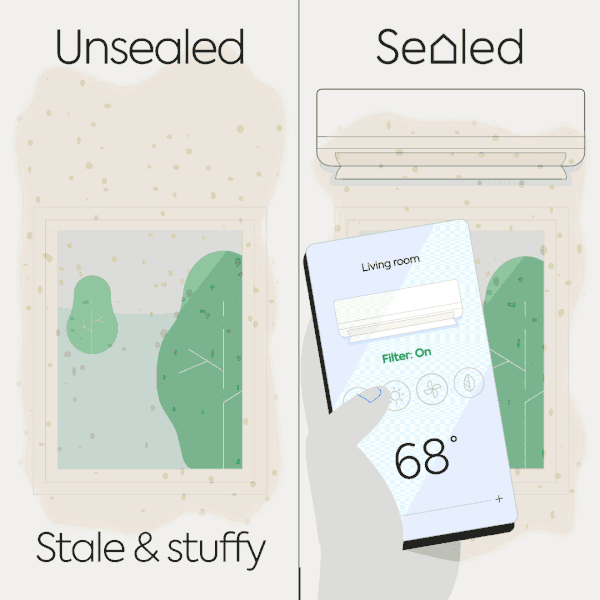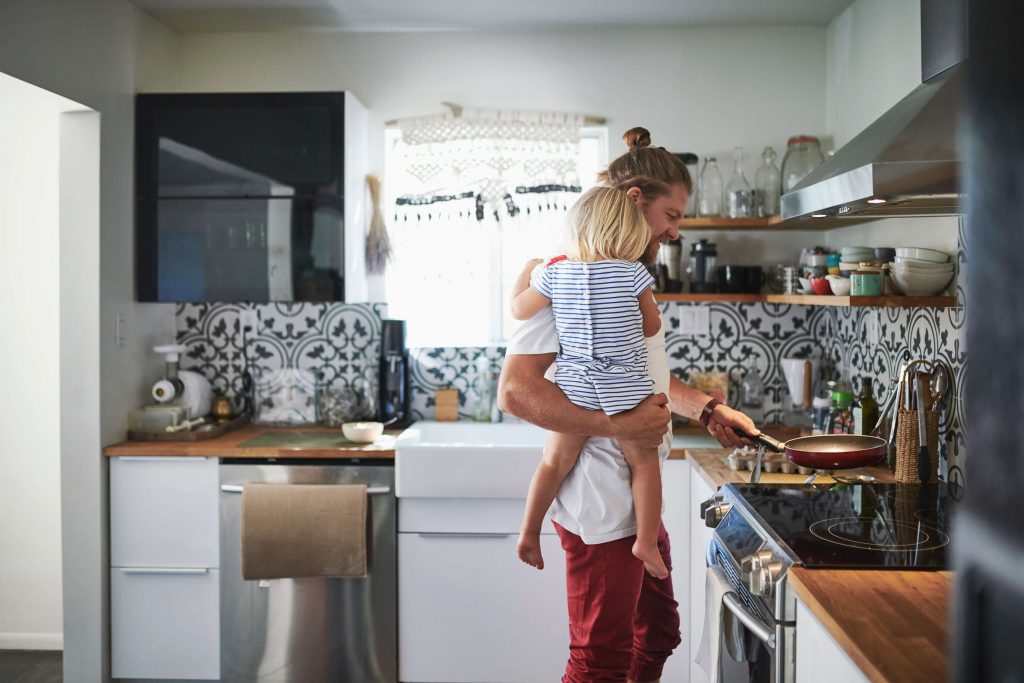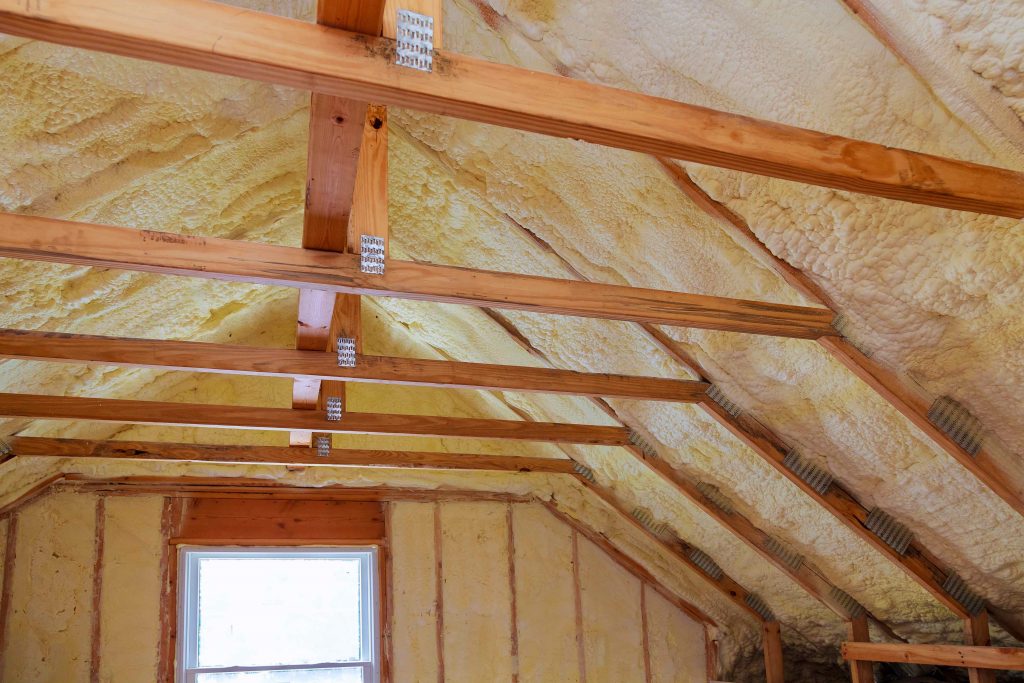It’s more important than ever to breathe fresh, clear air. Here’s how to make sure your indoor air is healthy and clean.
Wondering if your home is full of clean, fresh air? You’ve come to the right place.
We’re Sealed, and we’re committed to helping you improve the air quality in your home so you can breathe easy in a comfortable, healthy space. Learn how to get clean air with no upfront cost.
To understand good air quality, here’s what we’ll cover:
- What is poor home air quality?
- What causes poor home air quality?
- What are some examples of indoor air pollution?
- Does outdoor air pollution affect indoor air quality?
- What are the long-term health effects of poor home air quality?
- How to check indoor air quality inside homes
- How to improve indoor air quality inside homes
- How to get healthy indoor air at home—at no upfront cost
Key Takeaways:
The problem: A growing body of research suggests that poor indoor home air quality contributes to several major health issues.
Why this matters: On average, Americans spend 90% of their lives indoors.
What you can do: Improving your home air quality through filtration and circulation makes life indoors happier and healthier for you and your family.
What is poor home air quality?
So what is poor home air quality anyway? The short (and not-so-sweet) answer is, your indoor air quality is considered poor when it’s saturated with contaminants called Volatile Organic Compounds (VOC) and Particulate Matter (PM).
- VOCs are mostly airborne gasses, usually a byproduct of everyday chemicals found in your home (like cleaners and disinfectants).
- PM is the tiny dust or vapor particles constantly floating around in your air.
High levels of VOCs and PM lead to poor indoor air quality (IAQ).
Specifically, when VOC pollutant levels get above 400 ppb (parts per billion) the indoor air quality poses certain health risks (1).
For PM, size matters most when it comes to your health. PM (that is 100x thinner than a human hair) can enter your lungs and cause respiratory diseases (2).
Before we discuss the health risks associated with your home’s poor indoor air quality, let’s explore what causes it in the first place.
What causes poor indoor air quality in your home?
Volatile organic compounds and particulate matter are always in your home’s air.
In fact, your house itself contributes to higher concentrations of VOCs. Building materials including paint and carpet fibers emit harmful gasses (like formaldehyde) into the air.
Also, everyday tasks like cooking, cleaning, and heating your home release indoor pollutants. Your HVAC system and overall home ventilation can have a negative impact on your indoor air quality, too, if they’re not optimized for healthy airflow.
Let’s take a deeper dive into how these daily in-home activities release toxins into the air you breathe:
- Cooking: Cooking can dramatically alter the air quality in your kitchen—especially if you use a gas stove (3). In one recent experiment, researchers tracked the air quality while cooking a traditional Thanksgiving meal. They determined that the indoor air quality had deteriorated significantly enough to qualify as an “airborne toxic event” (4).
- Cleaning: Many cleaning products emit fumes that radically alter the quality of air in your home. In one study, mopping with bleach after cooking with a gas burner triggered a chemical reaction that produced nitryl chloride, a chemical known to create coastal smog (5).
- Heating: Fuel oil-fired heating appliances give off health-related air pollutants like sulfur at about 130 times that of natural gas heaters (6), and they can also become a source of carbon monoxide emissions.
Want more examples of indoor air pollution? The list is impressive:
- Household products like cleaners and disinfectants
- Boilers that run on heating oil
- Gas cooking stoves
- Furnaces that run on fossil fuels
- Water heaters that use fossil fuels
- Wood-burning stoves and fireplaces
- Natural gas fireplaces
- Aerosols, like hairspray, spray adhesives, and room air fresheners
- Candles and room fresheners that aren’t made of natural products
- Secondhand tobacco smoke from cigarettes
- E-cigarettes and vapes
- Off-gassing from new paint, flooring, carpeting, or upholstery
- Harmful substances such as radon gas, asbestos, or lead paint
- Chemicals used for home maintenance (like pesticides)
- Pet dander and dust mites
Yikes! After reviewing that list, it can be unsettling to see how many in-home pollutants affect your indoor environment on a daily basis.
But what about outdoor pollutants? Can they get inside?
Glad you asked…
Does outdoor air pollution affect indoor air quality (IAQ)?
Outdoor air pollution is a serious issue raising both public health and environmental health concerns across the globe. And—especially if your home lacks proper air sealing—you could be inviting some outdoor pollution inside your home.
And—this is shocking—Americans spend 90% of their lives inside (6).
Even more shocking? Researchers in the UK recently found that the air quality inside your home can be up to 10 times worse than the air outside (7). Whoa!
Learn how heat pumps can solve home airflow issues and how heat pumps dehumidify a home.
So even if a little outdoor air pollution is getting in, the real issue is what’s happening in your home—and what you can do about it.

The good news? You can do something about it, and Sealed can help. Tap here to jump ahead to the long-term solutions for improving your home’s indoor air quality.
That’s great news since indoor air pollution poses serious long-term health risks.
Researchers now know that indoor air quality can be up to 10X worse than outside air quality.
AllergyUK
What are the long-term health effects of poor home air quality?
Because research on indoor air quality is still in its early stages, scientists have yet to draw many definitive conclusions about long-term effects of your home’s air quality.
But we do know that prolonged exposure to air with high particulate matter and allergens has been proven to lead to respiratory issues like sinus infections and asthma attacks (8).
Volatile organic compounds cause health concerns, too. According to the American Lung Association, some VOCs can cause damage to your nervous system and even cancer (9).
Cancer is a scary word, so let’s pause here to talk about one of the biggest contributors to in-home pollution: gas appliances.
New research indicates that the natural gas delivered to stovetops contains benzene—which is a carcinogen that has no safe level of exposure (10).
And it’s important not to overlook other home appliances that use natural gas. Gas furnaces, for example, are not only less efficient, but can emit dangerous levels of carbon monoxide or CO2.
(That’s one of the reasons our Sealed team loves heat pumps: They run on clean energy.) Tap here to learn more about why heat pumps are the only HVAC system we install.
Before we move on, let’s take a quick look at other health risks associated with poor indoor air quality.
Natural gas heating is the largest in-home contributor to the 7.5 tons of CO2 equivalents produced by U.S. households annually.
ccfpd.org
IAQ health problems—a quick list
- UK researchers estimate that poor IAQ is linked to at least 9,000 deaths a year (11).
- The World Health Organization (WHO) estimates that 5% of lung cancer deaths can be attributed to airborne particulates (12).
- According to the Environmental Protection Agency (EPA), long-term effects of poor IAQ include respiratory and cardiovascular diseases and cancer (13).
- Household air pollution exposure can almost double the risk for pneumonia in young children, according to the WHO (14).
Those health risks are startling, but don’t worry: By taking a few smart steps—like creating healthy airflow and ventilation in your home—the negative impact of these toxins can often be mitigated altogether.
How to check indoor air quality in your house
Think you might have indoor air quality problems? If you want to assess your home’s air quality, you have a couple of options:
How to evaluate your home air quality yourself
If you’re into gadgets, you can go the high-tech route. A growing number of home air quality test kit units are available, but they’re pricey and not that great at showing you how to fix indoor air pollution.
Luckily, you actually don’t need an expensive monitor to see unhealthy airflow. You can identify many problems with the naked eye.
Look for these 6 signs of poor home air quality:
- Mold or mildew inside the house
- Steamy or drafty windows
- Uneven temperatures throughout your home
- Cold air drafts
- Ice dams on your roof
- Excessive dust
Get a professional to assess your indoor air quality
Many home ventilation and airflow experts can test the indoor air quality of your home and help you remedy the issues found.
At Sealed, we’re absolute nerds about home health and comfort—we’re here to make sure your home feels amazing year round and is performing optimally for your health. If you’re concerned about your home’s air quality, we can help you find the right solution.
Learn how home performance contractors can help solve your home’s comfort issues.
I wouldn’t hesitate to recommend Sealed for HVAC and insulation upgrades. If you’re looking to take on a large efficiency project for your home without the large upfront cost, Sealed is worth a look.
Matt R., Sealed customer
How to improve indoor air quality inside your home
Let’s explore both short- and long-term solutions to poor indoor air quality.
How to improve indoor air quality in the short term
Address unhealthy air or poor airflow in your house in five easy ways:

1. Open your windows.
Opening windows isn’t practical all the time, but if you’re cooking a big meal, an open window is a great (and fast!) way to facilitate healthy airflow in the kitchen.
2. Improve your kitchen ventilation.
A hood fan blows funky air out of the house or filters it before returning it to the kitchen. And switching from a gas range to an induction stovetop has also been shown to make a big difference in indoor air pollution.
Plus, induction cooking is much more efficient than gas cooking, as it uses up to 90% of the energy produced compared to only 40% with a gas stove (15). So switching is really a win-win!
3. Say so long to your fireplace.
That roaring fire may look nice, but bringing wood into the house and burning it for fire can really impact people with allergies and asthma, especially older adults.
4. Purchase in-room air purifiers.
In-room air cleaners or air purifiers are useful, but they often cover only a single room, so you would need to get units for all rooms where you spend significant time to realize the full benefit. Individually they can be expensive, and the cost of operation (electricity and filter replacements) can add up in a hurry.
5. Sound the alarm.
A carbon monoxide alarm is an essential, affordable tool for warning you of dangerous air inside the home. Every home should have them in key areas.
How to improve indoor air quality in your home long-term
If you want a big, lasting difference in your home, you’ll need to improve two things: your home’s ability to control airflow and your home’s ability to clean the air.
Sealed has performed this work for hundreds of homeowners over the years. We improve your home’s air quality through three main strategies:
Sealed has a fantastic business plan to assist homeowners to depart from oil and gas heating systems and [move] into the future of highly efficient HVAC electric systems.
Piper B., Sealed customer
Regulating indoor airflow
Professional air sealing and insulation throw a 1-2 punch that helps regulate airflow inside the home.
Insulation regulates temperature, which keeps the heat inside in the winter and outside in the summer. And air sealing prevents unwanted air from getting into the house through air leaks.
It’s important to note that both air sealing and insulation work should only be done by qualified professionals.
To learn more about how Sealed gets this important work right, read our guides to air sealing and insulation.
Whole-home air filtering
Changing your HVAC air filters regularly is smart, but it isn’t a permanent or long-lasting solution. At Sealed, we recommend installing an energy-efficient heat pump to keep your indoor air healthy and clean. Here’s why:
- Heat pumps constantly recirculate the air inside your home to keep it fresh.
- Heat pumps have built-in filters that filter everything that comes into your home.
- Heat pumps work to heat and cool your whole home—but they’re up to 3X more efficient than traditional heating systems and air conditioners.
Heat pumps are the only HVAC system we’ll install. We (and our clients) love them that much. In fact, we like to call heat pumps the Tesla of HVAC.
Converting from fossil fuels to electric heating
Heating systems that use fossil fuels (like heating oil and natural gas) emit harmful fumes into your home. Making the switch to electricity as the only energy source in your home eliminates this problem.
Not only are heat pumps the best way to heat a house—no matter its size or how old your house is—they also run on electricity. Goodbye, toxic fumes!
(Check out our winter heat pump guide to learn what temperature a heat pump stops working.)
Improve your home’s comfort and air quality—at no upfront cost
Improving your home’s air quality can get expensive, but we don’t think you should have to put a price on your family’s health.
Not only does air sealing, insulation, and HVAC work improve your indoor air quality, but it also can significantly reduce your energy bills.

With Sealed, you get powerful home upgrades that will improve your indoor air quality and energy efficiency—with an energy-savings guarantee and flexible payment options.
We’re here to help you breathe easier and make your home feel amazing!
To see if your home qualifies, answer our quick questionnaire.
Not only does air sealing, insulation, and HVAC work improve your indoor air quality, but it also can significantly reduce your energy bills.